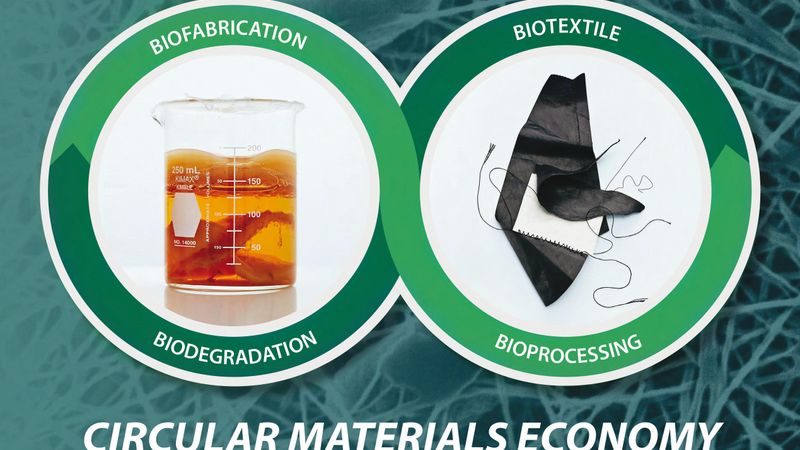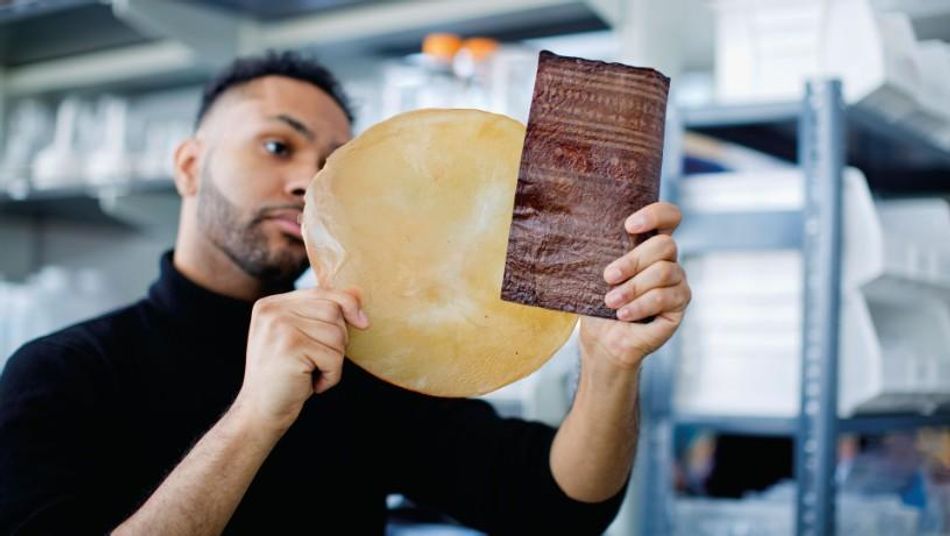Compostable Bioleather Offers Sustainable Solutions for the Clothing Industry and Beyond
Researchers at Columbia Engineering and the Fashion Institute of Technology team up to create a non-toxic bioleather, inspired by the power of microbes and indigenous science.

Microbial biofabrication and green processing inspired by cultural heritage offer a path to a circular material economy. PHOTO CREDIT: THEANNE SCHIROS/COLUMBIA ENGINEERING
Since the dawn of the Industrial Revolution, clothing production has been on an unsustainable path. Like most manufacturing, textiles are produced in a linear fashion with a cradle-to-grave model. Fabrics like cotton are farmed, worn, used, then thrown away. The textile industry as a whole is responsible for 10% of global carbon emissions, with leather being especially harmful.
The cattle industry is the single leading driver of deforestation, and the tanning of leather creates a great deal of chemical pollution. These challenges have motivated a search for more sustainable textiles, especially leather alternatives.
A team with a track record of successful collaboration may hold an answer. Biomedical Engineering researchers at Columbia Engineering recently announced they have created a compostable bioleather with superior flame-retardance and low environmental impact. Their microbial nanocellulose (MC) bioleather has a 1,000-times lower carcinogenic impact than cow leather and a significantly smaller carbon footprint than synthetic leather or cotton. Their study was published on July 1, 2022, in Environmental Science: Advances.
The team, led by Theanne Schiros and Helen Lu, together with Ph.D. candidate Romare Antrobus, has been working together for several years in Columbia’s Materials Research Science and Engineering Center (MRSEC) to develop materials for a broad range of applications from biomedicine to energy, electronics, and textiles laid the foundation for inventing this versatile new material.
“Our bioleather represents a breakthrough not only for textiles but shows other industries how to explore a sustainable manufacturing process to engineer regenerative materials,” said Lu, Percy K. and Vida L.W. Professor of Biomedical Engineering and Senior Vice Dean of Faculty Affairs and Advancement at Columbia Engineering.
Our bioleather represents a breakthrough not only for textiles but shows other industries how to explore a sustainable manufacturing process to engineer regenerative materials.
To make high-performance biotextiles, the team harnessed microbial biosynthesis of nanocellulose, drawing inspiration from pre-industrial and indigenous science. Schiros hypothesized that a main component of mammalian brain used for millennia to tan hides into leather--lecithin phosphatidylcholine-- would stabilize the interaction of cellulose with both water and lipids in a tanning emulsion, and modify the material properties of MC through its hydrophilic groups to make it suitable for use as a bioleather. When the researchers used traditional brain and smoke tanning processes, they noted an increase in tensile strength and ductility of MC, which encouraged this line of investigation. Their discovery led to the development of an eco-friendly, plant-based lecithin “tanning” process for nanocellulose that created a strong, compostable bioleather.
This new process will not only transform future textile development but also cultural heritage research. While civilizations around the world have been creating sustainable and durable textiles since antiquity, most of these ancient techniques have been lost.
“Our team is now collaborating with scientists at the Metropolitan Museum of Art to develop a conservation studies database for artifacts in their cultural heritage collections and to understand the mechanism behind historic brain and organ tanning,” said Schiros, associate professor of materials science at the Fashion Institute of Technology and adjunct associate research scientist in Columbia’s MRSEC.
Coming full circle to modern-day design, the researchers created a pair of naturally dyed, microbial bioleather sneakers in a collaboration with Public School NY. The sneakers are part of an exhibition, Towards a Circular Society: Learning from Nature, currently on view at the University of Bern’s Wyss Academy for Nature. They will also be on view in a separate exhibition at the Montreal Museum of Fine Arts.
This new study builds off the researchers’ successful rethinking of manufacturing through the lens of biomaterials and the circular economy, including two startups spun out of their labs, Algiknit, which makes kelp-based biofibers, and Werewool, which has created a platform for high-performance regenerative textile fibers with DNA-programmed color and function, such as stretch or waterproofing, provided by engineered proteins.
With their accomplishments in harnessing the power of microbes and developing paleo-inspired green processing techniques, Lu and Schiros expect biofabrication to play a critical role in facilitating a transition to a more sustainable economy. MC offers a modular engineering platform for high-performance regenerative materials with various applications, from tissue engineering to batteries, electronics, biosensors, and pollution remediation, which the researchers are continuing to explore.
Schiros believes the broad applicability of their research may only be a matter of time. She added, “The biofabrication approach developed here can incentivize and accelerate a paradigm shift to a circular materials economy, critical to global climate goals and sustainable development.”

